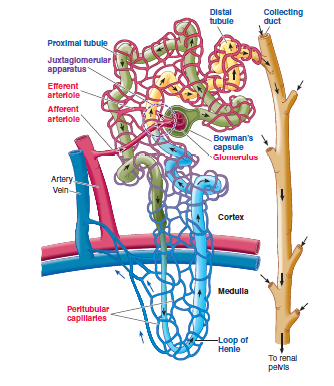
Glomerular Filtration, Renal Blood Flow, and Their Control
The first step in urine formation is the filtration of large amounts of fluid through the glomerular capillaries into Bowman’s capsule—almost 180 liters each day. Most of this filtrate is reabsorbed, leaving only about 1 liter of fluid to be excreted each day, although the renal fluid excretion rate may be highly variable depending on fluid intake. The high rate of glomerular filtration depends on a high rate of kidney blood flow, as well as the special properties of the glomerular capillary membranes. Here we discuss the physical forces that determine the glomerular filtration rate (GFR), as well as the physiological mechanisms that regulate GFR and renal blood flow.
As blood flows through the glomerulus, protein-free plasma filters through the glomerular capillaries into Bowman’s capsule. Normally, about 20% of the plasma that enters the glomerulus is filtered. This process, known as glomerular filtration, is the first step in urine formation. On average, 125 mL of glomerular filtrate (filtered fluid) are formed collectively through all the glomeruli each minute. This amounts to 180 liters (about 47.5 gallons) each day. Considering that theaverage plasma volume in an adult is 2.75 liters, this means that the kidneys filter the entire plasma volume about 65 times per day. If everything filtered passed out in the urine, the total plasma volume would be urinated in less than half an hour! This does not happen, however, because the kidney tubules and peritubular capillaries are intimately related throughout their lengths so that the tubular cells can transfer materials as needed between the fluid inside the tubules and the blood within the peritubular capillaries.
At the end of the lesson, students will be able to learn about
GLOMERULAR FILTRATION
DETERMINANTS OF THE GFR
REGULATION OF THE GFR
RENAL BLOOD FLOW AND ITS REGULATION
DETERMINANTS OF RENAL BLOOD FLOW
PHYSIOLOGICAL CONTROL OF GLOMERULAR FILTRATION AND RENAL BLOOD FLOW


